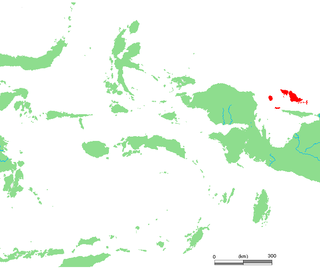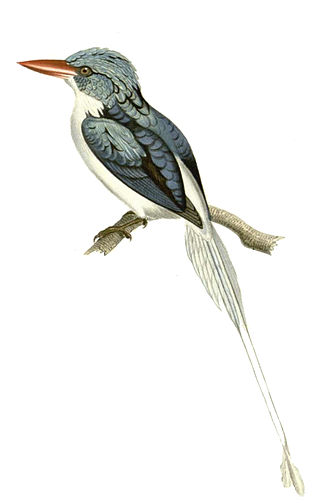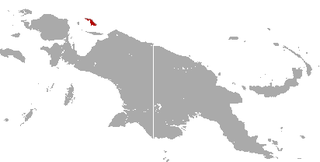
The Schouten Islands are an island group of Papua province, eastern Indonesia in the Cenderawasih Bay 50 km off the north-western coast of the island of New Guinea. The group consists of the main islands of Biak, Supiori and Numfor, and numerous smaller islands, mostly covered in rain forest.

The Biak paradise kingfisher is a tree kingfisher that is endemic to the Indonesian island of Biak which is one of a small group of islands located in Cenderawasih Bay near the northern coast of Papua. This bird has a turquoise-blue back with a white belly and tail streamers and a reddish beak. Its natural habitat is forests and the IUCN has assessed its conservation status as being "near-threatened".

Uromys is a genus of rodents found in Melanesia and Australia. They are known as the giant naked-tailed rats. There are eleven species in the genus, with the most recent described in 2017.
The Japen rat is a species of rodent in the family Muridae found only in Yapen, Biak-Supiori, and Owi islands of West Papua, Indonesia.
The giant naked-tailed rat is a species of rodent in the family Muridae. It is found in West Papua, Indonesia and Papua New Guinea. It lives in tropical forests, wetlands, and in degraded forests.
The masked white-tailed rat is a species of rodent in the family Muridae. It is found only in Australia, in north-east Queensland.
The emperor rat is a large species of rodent in the family Muridae. It is endemic to the island of Guadalcanal in the Solomon Islands. It is classified as critically endangered by the IUCN but may already be extinct.
The Bismarck giant rat is a species of rodent in the family Muridae. It is endemic to the island of New Britain, Papua New Guinea.
The Guadalcanal rat is a species of rodent in the family Muridae. It was found only in the Solomon Islands. Since this species was collected between 1886 and 1888 it has not been seen again. It is possibly extinct.

The common paradise kingfisher, also known as the Galatea paradise kingfisher and the racquet-tailed kingfisher, is a species of bird in the family Alcedinidae. It is found in subtropical or tropical moist lowland forests of the Maluku Islands and New Guinea. Like all paradise kingfishers, it has a red bill and colourful plumage. The species is common and the IUCN has assessed its conservation status as being of "least concern".
The Biak monarch, or Biak monarch flycatcher, is a species of bird in the family Monarchidae. It is endemic to Biak Island, Indonesia.

The Biak glider is a species of marsupial in the family Petauridae. It is endemic to the Schouten Islands in the western region of Papua Province, Indonesia. It was formerly considered to be a subspecies of Petaurus breviceps ; there is still uncertainty regarding its status as a distinct species.

The Biak naked-backed fruit bat is a species of megabat in the family Pteropodidae. It is endemic to Indonesia.
The king rat is a large species of rodent in the family Muridae. It is endemic to the island of Guadalcanal in the Solomon Islands. Like the two other species of rodent in Guadalcanal, it is placed in the genus Uromys. It lives in trees and is larger than Uromys porculus but smaller than Uromys imperator.

The blue-eyed spotted cuscus or Biak spotted cuscus is a species of critically endangered marsupial in the family Phalangeridae.

The Biak–Numfoor rain forests is a tropical moist forest ecoregion in Indonesia. The ecoregion covers the islands of Biak, Supiori, Numfoor, and several smaller islands, which lie in Cenderawasih Bay north of Yapen and New Guinea.
Emma's uromys or Emma's giant rat is a species of rodent in the family Muridae. It is only known from Owi Island, a small island of the size of about one square kilometer some 5km South of Biak Island, Indonesia.
The Great Key Island giant rat, or Great Key Island uromys is a species of rodent in the family Muridae. It is known only from Great Key Island, Indonesia.
The Vangunu giant rat, locally known as the vika, is a giant arboreal species of rodent in the family Muridae. The rat was discovered in the island of Vangunu in the Solomon Islands in 2015, after years of searching based on local stories, and described in 2017. It was identified as a new species on the basis of its skull, skeleton and a detailed DNA analysis. The single individual initially collected from a felled tree measured 46 cm long, weighed between 0.5 and 1.0 kg and had orange-brown fur. Its diet is believed to include thick-shelled nuts like ngali nuts and coconuts, and probably fruits. The species is likely to be designated critically endangered, due to the small amount of forest habitat remaining on the island and ongoing logging.








